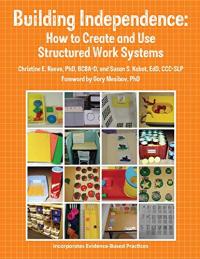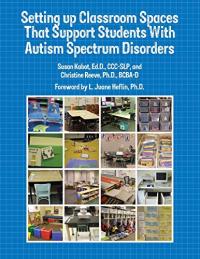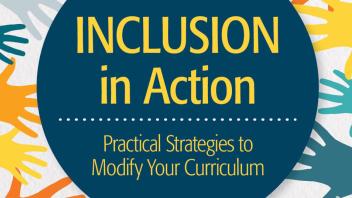
Dr. Reeve has been affiliated with Nova Southeastern University’s Mailman Segal Center for Human Development since 1997, as a faculty member and administrator. In 2010, Dr. Reeve founded Reeve Autism Consulting, where she provides technical assistance and professional development to schools around the country. Dr. Reeve is devoted to helping teachers reach students who have autism or severe behavioral issues.
Dr. Reeve has written several books for special education teachers including Taming the Data Monster and Setting Up Classroom Spaces for Students with Autism Spectrum Disorder. She authors the blog Autism Classroom Resources.
Dr. Reeve earned a Ph.D. in clinical psychology at Stony Brook University, New York.
Transcript
Why teachers need to collect data
I think for teachers, data collection is probably one of the hardest things that they do. Data is a really important component of any classroom, but in a special education classroom we have to really work at making sure we have it. So it’s important because we want to make sure we’re meeting the legal requirements to show that a student is making progress, but we also want to make sure that we’ve got the information we need to problem-solve. If a student is not making progress the data is what should tell us how to make changes so that we can get the student to where we want them to be.
We don’t have to take data on every single thing that the student does every single minute of the day, but we do have to have good samples and a good plan to give us the information that we need so that we can make instructional decisions.
It’s hard to take data while you’re also working with the student. And I think the biggest challenge teachers face many times is that taking data and writing things down means that I can’t necessarily attend to the student the way that I want to. And so sometimes it feels like it really gets in the way of instruction. So we always want to balance our plan for data to be something that gives us information we need, but not something that interferes so much with our actual engagement with the student, because if we don’t have good engagement and we don’t have good instruction, our data isn’t going to be able to help us.
Developing a good data plan
So the first thing in looking at what data you need to take is to know what skills you’re tracking, and you want to make sure that when you’re writing goals and objectives that you are writing the goal so that it’s clear, so that you know exactly what the behavior is that you’re looking at. So instead of saying, “I want to see how many times he gets angry,” well, angry can look very different.
It might be that when a student gets angry he throws things, or it might be that he just gets very quiet and withdraws from the situation. So I don’t want to say that it’s something that I can’t see. I might say, “How many times does he throw something? How many times does he kick something?” I want to use behaviors that I can specifically look at and know that this is happening and I need to count it.
That’s going to make sure that everybody is taking data on the same thing. I also want to make sure that when I write my goals that they have good measurement tools written into them. So if I’m working on a student initiating with a peer, I don’t want to write it that he’ll do it four out of five times because the times that he doesn’t do it I can’t — I don’t know how to count that. I don’t know how to count that opportunity, because he could initiate anytime.
So instead I might want to write the goal that he’ll do it three times in a 15-minute activity. That way I’ve limited the amount of time I have to take data, and all I have to do is count it. I don’t have to watch him all day to see how often he does it.
Measuring academic progress
You can’t have really good data collection unless you have really strong goals and objectives.
If I’m working on a math goal, I want to make sure that I’ve included the supports that the student can have, and in what kind of situation he’s going to be demonstrating that skill. Many of our students can demonstrate a skill in one situation but not another. So they might be able to use blocks as manipulatives to figure out an addition problem, but they may have a hard time doing that with just tally marks.
So I want to be specific when I write my goals about what kinds of situations the student’s going to be in when he does that. So is it going to be in a one-on-one situation or is it going to be in the general ed classroom, because those can affect his performance. I also want to make sure that I’m clear in my goal that he’s going to use a specific kind of manipulative or that he has access to manipulatives to use them to complete the problem.
So I want to make sure that I’ve built those supports and those areas of where he’s going to do it and with whom into my goal as well.
Building relationships with students with autism
All of our students with autism are different. But one of the things that I think is critical for interacting with any student, but is sometimes hard with a student with autism, is working on building a relationship with them. I think one of the building blocks of working with a student and figuring out what they need is pairing yourself with the things that they like.
So for some students, you’ll meet them, you’ll automatically have a relationship with them. But for some of our students who are more severe, you may need to really pair yourself with an object or an activity that he really enjoys. And if you can make yourself part of that reinforcing experience, that’s how you begin to build a relationship with him, and that’s how you begin to know kind of what makes him tick. It may be something as silly as he really likes to take tape off the teacher’s desk and turn it inside out and play with it. But if you can then make yourself, “I’ve got the tape, let’s play with it,” that gives you that entree to begin to make a difference and build a relationship with him.
For students who are very withdrawn, who are not really interacting with anybody very much, I think one of the things that we can do is really take our level of interaction down and our expectations down. I think we have a tendency to really kind of want to get in kid’s face and go, “Hey, let’s do this!” And for some of those kids that might be very intimidating. So when you’ve got a student who’s pretty withdrawn, watch him and observe him, and see what he likes to do. What is he drawn to? And so then figure out how you can make yourself part of that interaction. Find the thing that he likes, and make it more fun because you do it, but don’t immediately insert yourself into his world so much as figure out where he’s at and follow his lead.
Predictable routines for children with autism
When we go to develop an environment for a student with autism, whether it’s a classroom or a home environment, the routine and the predictability is really important. We all benefit from predictability and routine. We all have routines during our day that we follow because it keeps us from having to think about every single thing we do every day. It’s the same for our students with autism, they just need it a little bit more explicit, and they need us to set up those routines for them.
So the more that we can have a predictable schedule where everything’s happening in a similar order each day, the more that we can do the same things in the same place in the classroom, the easier it’s going to be, because he’ll be able to focus more on what he’s doing when he’s there, and less about, “What am I going to do next?” or “Where am I going to go?”
They can focus on the now, and we know what’s going to come next. They can see it on their schedule, they know what’s happening in their routine, so they don’t have to worry about it as much. So it reduces their anxiety in that way.
Dealing with challenging behaviors
So when we’re dealing with challenging behaviors, the question I always ask is, “Why is the student doing it?” We need to know the function of the behavior more than we need to know what the behavior looks like. So if a student is biting, the question isn’t, “What do I do about biting?” The question is, “Why is he biting?” I always want to know — is he doing it because he wants my attention? Is he doing it because he wants me to go away? Is he doing it because the situation’s overwhelming and he wants to be removed?
There’s a lot of different reasons why that behavior might be happening, but the reason is what’s going to tell us what we should do about it. So if he’s doing it because he wants people to react to him, how could he get that kind of reaction in a more appropriate way? Could he tell jokes? Could we make him the class spokesman? Could we do something that gives him that opportunity to be the center of attention and reinforce that, and not make a big deal about the biting? Maybe attend to the student who got bit instead of the biter.
Similarly, if he’s doing it because he needs to be removed from a situation, we might teach him to say, “I need a break,” which means get me out of here, and then give him that opportunity to leave when he’s making that request instead of when he’s biting. And then from there we can then build up into, “I can wait a little bit for the attention,” or, “I can do a little bit before I take a break.” But we’ve got to start where he’s at to get that need met, because that need isn’t going to go away. We could just say, “Well, he does it for attention so we’re going to ignore him.”
But then we just have to fight through waiting for him to learn that as opposed to giving him a way to get that need met in a more appropriate way.
I think it is very hard for the teacher, and it’s very hard for families and teachers because they’re both on the front lines of having to deal with this. And nobody wants to get hit or kicked or bit. But I think the advantage of working on looking at the function of their behavior means I’ve got something I can get him to do instead, which often then short-circuits the behavior, because now he can get what he wants and get what he needs without us having to wait through, “I just have to stand here until he stops spitting, so that I’m not attending to him.”
Now I’ve got something that I can say: “Tell me my name. Oh! Now I can talk to you, because you called my name.” So we can build up strategies that we can redirect him to, and it makes it easier. It gives us a way out of that situation.
Avoiding power struggles
Power struggles are really, really hard for anybody to get away from. I think they’re one of the things that some of our kids just suck us into. They’re very, very good at that. And I think it’s important that we remember that we don’t have to show up for every argument that we’re invited to, and that sometimes we win by letting him have his way.
So I think we have to be very careful about thinking about, “What is my goal in this situation? Is my goal to keep my classroom under control? Is my goal to keep him so that he is doing okay? Then maybe I’m not going to argue with him about this.” Sometimes you have to take a step back, sometimes you have to take a deep breath, count to five, whatever it is that helps you cope with it, but then come back to it with, “I need to give you a choice.”
“You know, you can do this or you can do this.” As opposed to just, “You’re going to do this, and I’m going to stand here until you get it done,” because unfortunately the student has all the time in the world to put into a power struggle, and you don’t as a teacher. As a teacher you have other things you have to do, so they’re always going to win. So we have to find a way to get what we want, as opposed to just saying, “Well, you’re going to do what I want you to do.”
Reinforcing good behavior
We want to find the things that the student is reinforced by and use those to catch — when we catch him being good. So if we’re working on keeping him in a group activity for a longer period of time we want to do it slowly. We want to break it down and just, you know, today he stayed for a minute and he got a reinforcer. Tomorrow he stays for two minutes and he gets a reinforcer.
And gradually we increase our expectations of the skills that we want to see. But by me giving clear expectations, by giving reinforcement for following through on those expectations, and taking a lot of the unpredictability of the environment away, a lot of times we can prevent some of the behaviors from occurring.
Using visual cues to help children with autism
Visuals, I think, are one of our most powerful tools for students with autism, and I also use them for lots of other students, because – for a few reasons. One is many of our students with autism process visually better than they process auditorily, and really we all process better visually than we do auditorily. You know, there’s a reason why a stop sign is a sign that we see and not somebody standing on the corner going, “Stop, stop, stop.” Because we don’t process auditory information as quickly.
So a lot of our students respond better to the visuals. They also can’t argue with the visuals, and when you give a verbal direction you often get an argument back which then sucks you into a power struggle, whereas if I just show you a visual, you got to do it. I used to have a little kid that used to cover his eyes if I showed him a visual. It was his version of, “I’m going to put my finger in my ears,” because he knew, “If you show me that thing, I have to do it.”
It is amazing to me sometimes when you show a student a visual that they’ll follow it, whereas if I gave them that direction they may not follow it because they might not understand it. They may not follow it because they didn’t understand what the action was that went with it. So they knew the word but they don’t really know what you want them to do, whereas if they see a visual it’s like, “Oh, I stand up. I see a picture of somebody standing up, I do that.” So it just takes some of the power struggle away and it makes the information clearer.
It also makes it, as a teacher, easier for me to kind of ignore the behavior because I know I’m giving a clear direction. So I don’t feel the need to continually repeat it, so I can wait him out a little bit.
Generalizing a student’s skill
A lot of students with autism really struggle with generalizing their skills from one situation to another, one person to another. So they can do it when they’re sitting in this place, but they can’t do it when they’re sitting in that place. It causes a lot of situations with teachers and families sitting at the table and one saying, “Well, he can do it,” and the other one saying, “He can’t do it.” And so one of the things I think that’s key is we’ve got to make sure we’re teaching in a way that teaches it in a general way.
We’ve got to make sure we’re using different materials, because we have students that will memorize the answers. We want to be sure that whatever we’re giving a student, we’re mixing things up frequently, because if I just gave him a game where all the pieces always went in the same place, I’ve got a lot of kids that just know, “Well, that’s the place it goes.” But they didn’t actually learn the concept. Many of them have other things that are affecting their ability to focus that day too.
So sometimes we see he could do it today, but he can’t do it tomorrow, and it’s not that he’s giving you a hard time, it’s that he really doesn’t know it today in the same way that he did it tomorrow, or you presented it in a different way than you did yesterday, or, “You’re a different person asking me to do it and so I can’t do it.” So there’s a lot of pieces that go into it. We want to use a wide variety of materials, have him work with multiple people, we want to make sure that he doesn’t just learn how to do things with one person because then we’re going to end up with a student when that person’s absent who doesn’t have the skills. And we want to make sure that we are communicating across settings, so that we know if Mom says he can write his name at home, we want to make sure that if we’re not seeing that our questions should always be, “What — how do you do it? Let me start where you’re at,” and if he can only write his name with a green pen, then I’ll start with a green pen and then we’ll change up the pens.
But I think it’s important that families understand that teachers are not saying that they’re doing something that they can’t do at home or the opposite. I think there sometimes is that, “Well, he’ll do it for me.” It doesn’t mean you’re any better at doing it, it just means he learned it in a different way and now we need to move that over someplace else.
Dealing with inconsistent performance
So it’s really common for students with autism to have differing performance on different days, and it leads people to think that they’re being difficult or, “You had it yesterday, why can’t you do it today?” And it’s very frustrating for teachers to see that because it’s like, “I thought you had that skill and now it’s not there.”
Many times that’s because we’re asking them to do it with different materials. Sometimes it’s because there’s other things that are impacting their ability to do it. Yesterday he came in and he was really on, and his attention was great, and he was able to sit and do his reading with no problem. And then today he’s more distracted, there’s more stuff going on, maybe he hears the lights or there’s more activity going on in the classroom and he can’t focus on it in the same way, so we don’t get the same performance.
And then sometimes there are just kids that come in and one day they can do it and then they don’t have it the next day. So they need a lot of repetition. They need to learn skills with a lot of different materials and in a lot of different situations before we’ve really determined that they’ve mastered it. Because otherwise we may find down the road we’re going to have lost those skills.
Helping children with autism succeed in a general education classroom
When we include a student with autism in a general education classroom — obviously every child is different so we need different supports, but there are some things that we can do that we can help to assure that they will be successful.
One is to make sure that we’ve got visual supports in place so that throughout the day he may have a schedule, he may have even a schedule of a specific task broken down, making sure that we are taking the anxiety out about what’s going to happen next and not just relying on the teacher telling everybody what’s going to happen next. He may need to see it.
Another is to make sure that he has a consistent schedule so that when he’s going in it’s a similar routine each day and not just, “Well, one day we do this and one day we do that.” That’s going to be very hard for a lot of students.
Another is to make sure that we’ve got our behavioral supports in place, so we may need to use a token board or something like that, where we’re using pennies for every minute that he stays in the group we’re reinforcing him.
We might use social stories to present new information of the expectations of what needs to be done. And I think the most important thing is to find a way for him to really be deeply engaged in the activity. Most of our kids are not really good at sitting and waiting or waiting their turn in a group activity, so sometimes it’s good if we can use something like response cards, where every student has a card and they can hold up the answer and the teacher can scan the room.
Then every student participates every time the teacher asks a question, which keeps our students more engaged — everybody’s more engaged, but it reduces the downtime that is often very difficult for our students.
Managing intense interests in the classroom
A lot of our students with autism get fixated on very narrow things. So it might be they’re, you know, obsessed with baseball, or it might be just an item, from a lollipop to a toy. And I think one of the things that we can do is take that as the first thing that they really love and start to use that as kind of a reinforcer for — let’s play with that. Let’s do something with that. Let’s build a relationship with that, and then let’s start putting it to the side: “Do something for me and you get it back.”
And so I do something that we call a parking lot, where he has a place he can put it, he knows he gets it back as soon as we finish what we’re working on. So it’s just teaching him that you can focus on those things — we all have interests that we focus on, we just know when it’s okay to do it and when it’s not. That’s what we have to teach him to do.
So if we have a student who is focused on something like baseball, we can build that into activities that he does. Maybe some of his math problems are focused on baseball games; maybe some of his work system tasks are based on baseball kinds of things.
We can tap into that as a resource for getting him engaged and refocusing him on a broader top set of topics to talk about it as well, so that he’s not fixated just on what happened yesterday.
Getting students to accept each other
One of the things that that I get asked a lot is, “How do I introduce this child to a class — to a general ed classroom? What do I say about him?” And I think a big piece of that is, A, talking with the family to find out what they’re comfortable with you sharing with the other students. Are they comfortable with the other students knowing they have a disability? Usually the other kids will pick up on it, so usually I don’t think it’s a problem to share it.
I think then explaining that everybody’s different is a really key component, because there are other kids in the class that are going to have differing behaviors, not just this kid. So we don’t want to really single him out.
So sometimes I’ll do the, you know, “How many people have blue eyes and how many people have brown eyes? Everybody’s different. Sometimes he needs a little extra help, just like you need a little extra help with your math.”
So I try to normalize it in that way. Sometimes we’ll read a book, sometimes we’ll talk. I think the biggest thing is just to let kids know that they can ask questions, and sometimes you’ll be really surprised about the questions that they’ll ask. So when I open it up to questions, when I talk with a class and they say, you know, “Is there anything you want to know?” sometimes their questions are things like, “Well, is he going to get any taller?” It’s like, “Okay, well, I have no idea. Probably! So are you.”
But you know, their questions often aren’t related to the autism at all. So I think that kind of normalizes it, because they have those questions about everybody. So I think we want to focus on it not being such a different thing, but answering their questions as they have them.
So my focus when I work with schools is always, how can we make students as independent as they can be? How can we foster whatever independence they have? Because that’s going to make the biggest difference for them when they leave school to go out on their own.
Find this author’s books on these booklists
Themed Booklist
In the Classroom: Teaching Children on the Autism Spectrum
Themed Booklist



